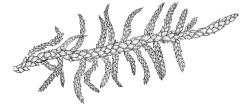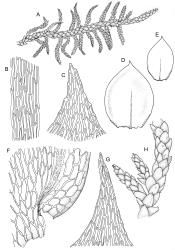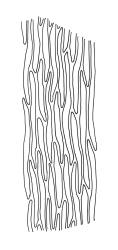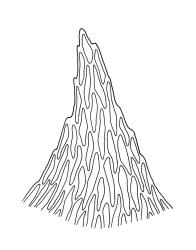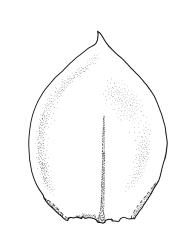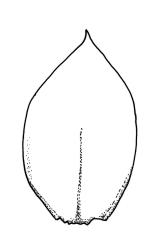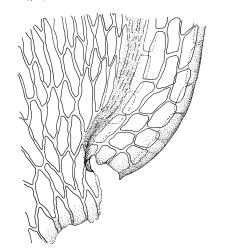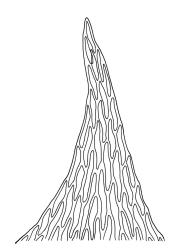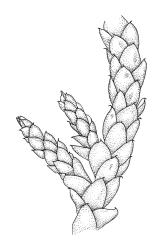- ≡ Hypnum purum Hedw., Sp. Musc. Frond. 253 (1801)
- ≡ Scleropodium purum (Hedw.) Limpr., Laubm. Deutschland 3, 147 (1896)
- ≡ Brachythecium purum (Hedw.) Dixon, Stud. Handb. Brit. Mosses 410 (1896)
Plants robust, lustrous, forming loosely interwoven mats, yellow- or white-green. Stems mostly ascendant, (40–)60–100(–150) mm long, pinnately or subpinnately branched, tumid and julaceous, lacking paraphyllia, in cross-section with several layers of thick-walled cortical cells surrounding thinner-walled cells and a small central strand, beset with scattered fascicles of red-brown and smooth rhizoids. Stems and branch leaves differentiated only by size. Stem leaves loosely erect, imbricate, broadly oblong-ovate to nearly cochleariform, abruptly tapered to an apiculate and reflexed apex, strongly concave, often weakly plicate when dry, denticulate above, plane at margins, not decurrent, mostly c. 1.5–2.1 × (0.8–)1.0–1.5(–1.8) mm. Branches variable in length, mostly 8–15 mm, often cuspidate at apex. Branch leaves mostly 1.3–1.5 × c. 0.8 mm, weakly to markedly reflexed at apex. Costa slender, unbranched, extending ½–⅔ the leaf length, terminal spine apparently absent. Upper laminal cells linear-vermiculate, firm-walled, weakly prorate at upper or both ends, not porose, mostly 65–85 × c. 4 µm, becoming shorter towards leaf apex; basal cells shorter, thick-walled and porose in several rows; alar cells thick-walled, subquadrate to short-irregular, forming a small and poorly defined concave group. Axillary hairs 7–11 cells long, with pigmented basal cells.
Dioicous. Perichaetia inconspicuous, gemmiform, scattered on main stem; perichaetial leaves spreading, ovate-lanceolate, ± entire, ecostate, c. 1.4 mm, surrounding c. 12 archegonia and numerous filiform paraphyses. Perigonia not seen. Setae c. 20–30 mm, smooth, sinistrorse; capsules inclined, short-cylindric, c. 2.0 mm, dark brown; exothecial cells irregular, incrassate. Exostome teeth dark, transversely striate below, strongly trabeculate; endostome detail not seen in N.Z. material. Spores c. 15 µm.
Crum & Anderson 1981, fig. 529; Buck 1998, pl. 92, 1–9; Smith 2004, fig. 279; Seppelt et al. 2011, fig. 3.
The combination of its weedy habitat, its usually robust size with tumid, julaceous and subpinnately branched stems, and its imbricate, broadly oblong-ovate leaves, which are abruptly tapered to an apiculate and reflexed apex, make P. purum an easily recognised plant.
Confusion is most likely with the poorly known (in N.Z.) Scleropodium touretii, and features that distinguish the two species are discussed under that species.
Pseudoscleropodium could also be confused with Calliergonella cuspidata, but that species has non-julaceous stems, non-reflexed leaf apices, mostly ecostate leaves with distinctly inflated alar cells, and it generally grows in wetter sites. Confusion with Acrocladium chlamydophyllum seems less likely; that species is more irregularly branched and has nearly cochleariform, broadly rounded, and non-reflexed stem leaves with porose laminal cells. Acrocladium chlamydophyllum is also autoicous and frequently fruits.
NI: N Auckland, S Auckland, Gisborne (near Ōpōtiki, Raukokore River), Hawke’s Bay (Havelock North, Wakarara), Wellington; SI: Nelson, Marlborough, Canterbury (McLeans I., Hororātā), Westland, Otago (near Palmerston, Dunedin area, Tahakopa, Thisbe Stream), Southland (Hamilton Burn, near Borland Lodge, Pourākino River); St; Ch (including Pitt I.).
Adventive. Buck (1998) gave the world distribution of this species as “maritime Canada, coastal Pacific Northwest [America], Argentina, Chile, numerous Atlantic islands, Réunion, Japan, Sri Lanka, New Zealand, [and] Jamaica.” Also occurring in Tasmania*, south-eastern mainland Australia*, and Hawai‘i. Buck considered it to be “presumably native to Europe but now widespread due to introduction, often with nursery stock.” It is sometimes employed as mulch on pot plants in the N.Z. horticultural trade, which no doubt facilitates its spread regionally.
Mainly in roughly mown lawns, pastures, and roadside and track verges. Also occurring in Pinus radiata plantations, gaps in native forest, disturbed sites in subalpine scrub (as at Mt Fyffe, Marlborough L.D.), and in native Kunzea ericoides scrub (as at Kaikōura, Marlborough L.D.). Thuidiopsis furfurosa and Hypnum cupressiforme are frequent associates. On the North I. from near sea level to at least 820 m (National Park, Wellington L.D.), but apparently uncommon above c. 600 m; on the South I. mostly from low elevations but extending to c. 1000 m (Mt Fyffe, Marlborough L.D.).
Sporophytes are extremely rare in N.Z. (and throughout the species’ range), as reflected in the partial description above. Only two intact capsules (from Kaikōura, Marlborough L.D., J. Lewinsky 1095, CHR 348580) and a few fragmentary capsules in material from Havelock North have been seen. A more detailed description of the sporophyte can be found in Buck (1998, p. 235). Perichaetia are quite inconspicuous and seem to be infrequent in N.Z. material.
Crum & Anderson (1981, p. 1078) refer to P. purum as “a robust moss with softly julaceous stems and branches and broad, concave leaves, rounded-obtuse and abruptly apiculate at the tip.” According to Dixon (1896, p. 410), in Britain this species is “frequently employed by anglers for scouring worms.”
Sainsbury (1955, p. 451) reported P. purum from a suburb of Auckland and from Nelson. The former is based on two 1930 collections from the neighbourhood of Mt Eden by L.B. Moore. Several collections were made by K.W. Allison in the Dunedin area in 1951–52.
It is probable that the spread of this moss, particularly on the South I., has been both recent and rapid. In 1976 John Linzey wrote to K.W. Allison (notes preserved in CHR 433091) that P. purum is “extremely widespread in the Auckland Province. I have found it near Whangarei & all over the Coromandel. It is very common sight throughout the Waitakere Ranges among grass on forest edges & forest opening. I have never found fruit & [sic] not found in S Is.” Subsequently Lewinsky & Bartlett (1982) recorded it from in excess of 30 localities, including seven on the South I. They suggested that the species seemed “to be spreading vigorously in New Zealand at the moment” and concluded that it should be considered an introduction. They also recorded sporophytes from Marlborough material, which they believed were the first capsules found in the southern hemisphere.
Although the type of P. purum Hedw. has not been seen, there are images on JSTOR Global Plants (accessed 11 June 2018) of three specimens in the Linnaean Herbarium (LINN). Hedwig’s protologue referenced both Linnaean and Dillenian polynomials. The JSTOR images of the fruiting material in the Linnaean are easily recognisable as representative P. purum.



